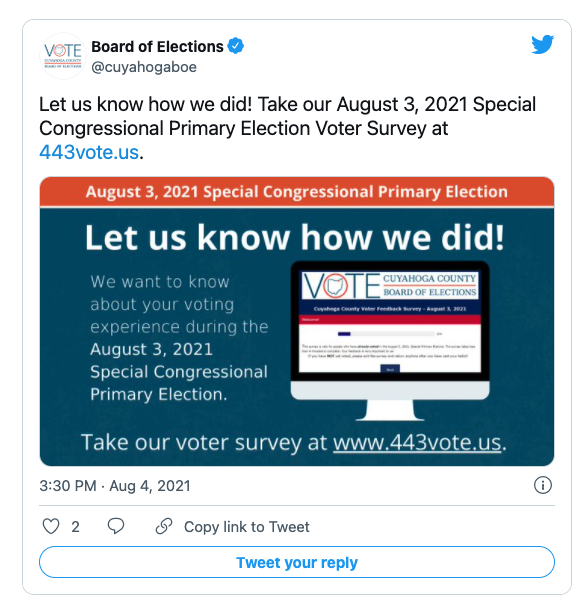Cuyahoga County, Ohio Uses Voter Surveys to Receive Feedback
This spotlight was featured in our ELECTricity newsletter in August 2021. Sign up to receive more success stories from election offices across the country.
As technology advances, populations shift, and unexpected circumstances arise, election officials make adjustments to better serve their voters. They update their voting equipment, recruit younger poll workers, find creative solutions for voter education, and much more. But as you plan for the future, how can you be confident that you’re making the modifications that voters actually want? And how can you be sure that your team is performing well?
In Cuyahoga County, Ohio, election administrators have taken a direct approach to understanding their voters’ wants and needs. Since 2014, they’ve been collecting voter feedback via online surveys. The surveys have been a great way for voters to feel heard, and their feedback has helped drive the Board of Elections’ continuous improvement.
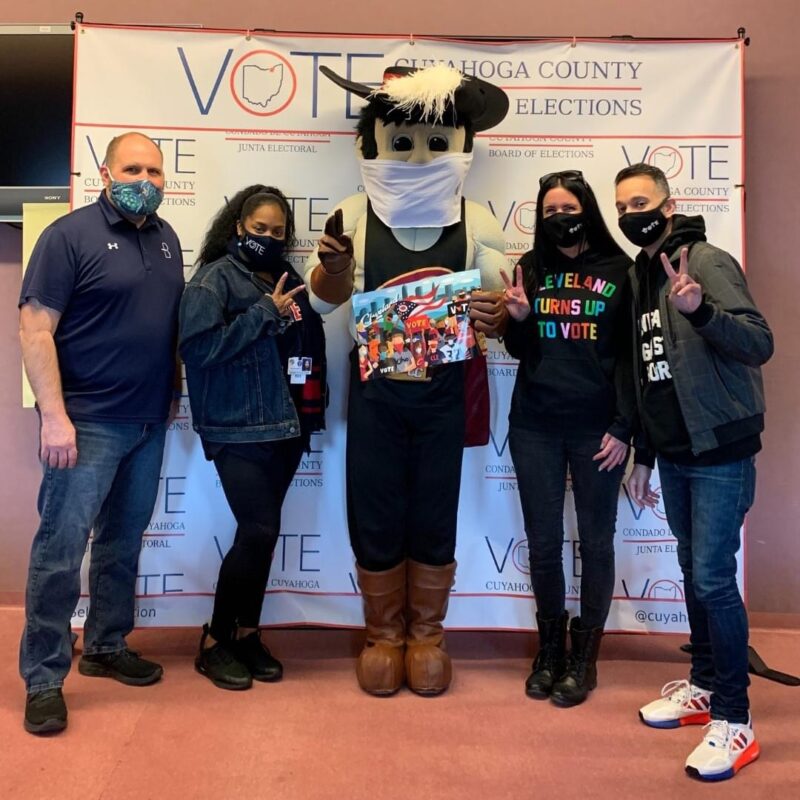
Using SurveyMonkey to Listen to Voters
Cuyahoga County is named after the “crooked river” that cuts through the county’s center and flows into Lake Erie by downtown Cleveland. Overlooking the lake is the Rock & Roll Hall of Fame, which attracts over half a million visitors every year. Cuyahoga County is home to nearly 900,000 registered voters, and the Board of Elections’ voter surveys ensure that each of those voters’ questions and concerns can be heard.
Peter James is the Election and Compliance Administrator at the Cuyahoga County Board of Elections. He and his colleagues have conducted post-election voter surveys for 15 elections, so they are experts in collecting feedback. But when they first implemented the program in 2014, they needed to find a tool that would make listening to all of their voters’ voices as seamless as possible. They chose to use SurveyMonkey, a relatively inexpensive survey tool that makes collecting a large number of responses feasible. “It’s a recognizable brand,” Peter says, “which adds a level of credibility when a voter considers whether to complete the survey or not.” And while SurveyMonkey has powerful analytics capabilities, the program is intuitive and does not require a high level of skill to use. “Most of our employees have used SurveyMonkey at some other point in their professional or personal lives, also making the learning curve smaller,” Peter adds.
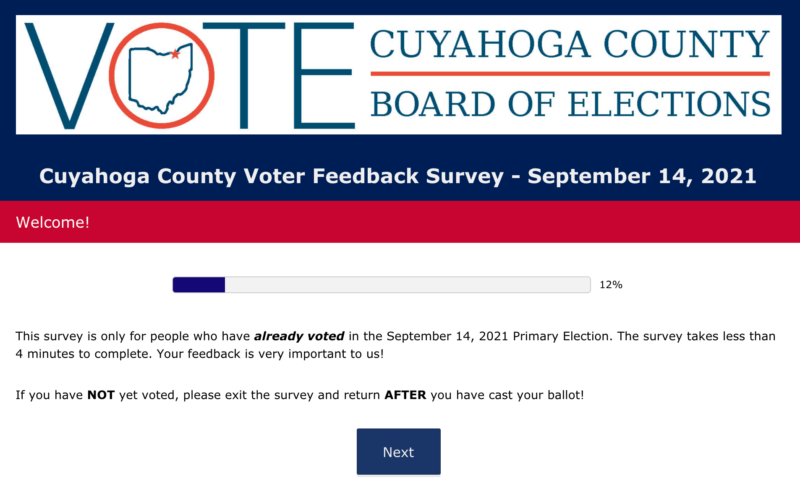
Asking the Right Questions
Each election cycle, the Board of Elections drafts survey questions to ask constituents about their voting experience. “We attempt to ask questions that will solicit responses that could potentially change a process or procedure we are currently doing,” says Peter. “The voter survey doesn’t have much value if there isn’t a potential to use the results to improve how we run elections.”
With that in mind, the staff starts by breaking down the questions into three categories, one for each voting method available in Ohio: early in-person, vote by mail, and on Election Day at the polls. They ask voters who mailed in their ballots if the instructions on how to fill out the application and return the voted ballot were clear. And they ask those who voted in-person if wait times were short and if poll workers were helpful. The survey also includes general questions, such as a rating for the overall voting experience, and a space for voters to add any suggestions that they have for improvement.
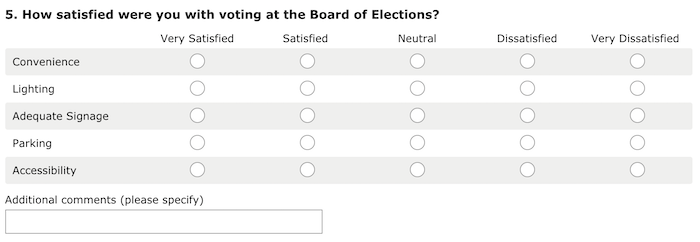
Encouraging Voters to Participate
Once the team finishes writing the questions and publishes the questionnaire in SurveyMonkey, it is time to share it with their voters and start collecting responses. The Board of Elections informs voters about the survey in a variety of ways. When voters have finished voting in-person, poll workers hand them a postcard, which includes a QR code. Voters can scan the QR code on their smartphones and it will direct them to the online survey. Peter says that this method has been the most effective tool in driving voters to complete the survey. It’s a simple way to remind them to share their thoughts and suggestions while they’re still fresh in their minds.
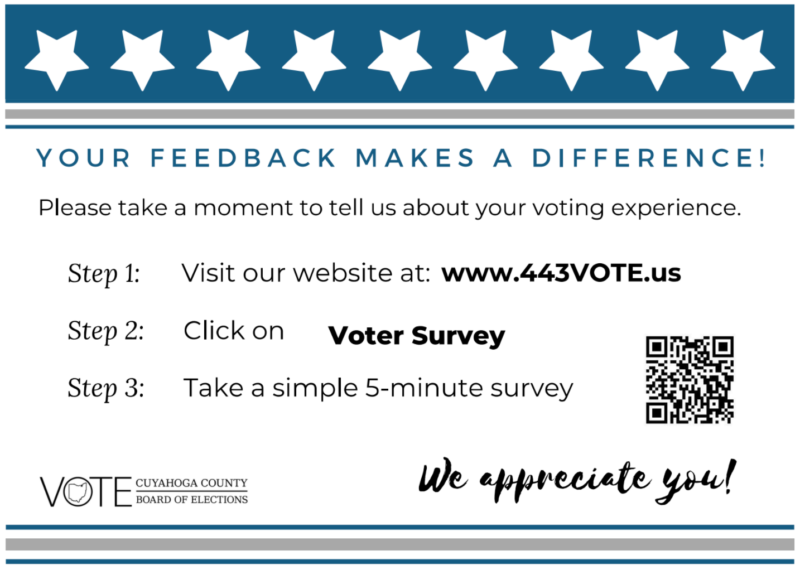
The Board of Elections also uses digital tools to spread the word. The homepage of the Cuyahoga County election website has a link to the survey. Voters can access the link throughout the absentee voting period and for several weeks after the election is completed. The Board of Elections also promotes the surveys through their Facebook and Twitter channels using eye-catching graphics.
Analyzing Results and Responding to Feedback
After voters have taken the survey, the elections staff can start to analyze the results. The process is simple since SurveyMonkey’s software includes built-in data visualization tools. “For questions that are multiple choice, yes/no, or ranked voting, SurveyMonkey automatically does the calculations, both in percentages and overall total responses,” Peter explains. It also creates colored bar graphs, which makes it easy to understand the data at a glance. For open-ended questions, you can browse through all of the comments, and can create a wordcloud of the most common words that came up in the responses. You can also use tags to organize comments based on either negative or positive feedback. As you analyze the results, you can be sure that they are as accurate as possible, since SurveyMonkey prevents users from submitting more than one survey response from a single device.
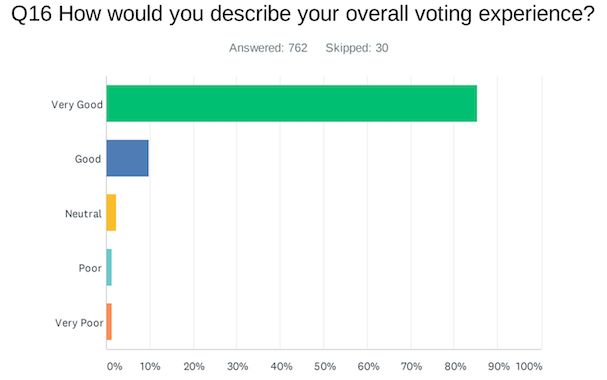
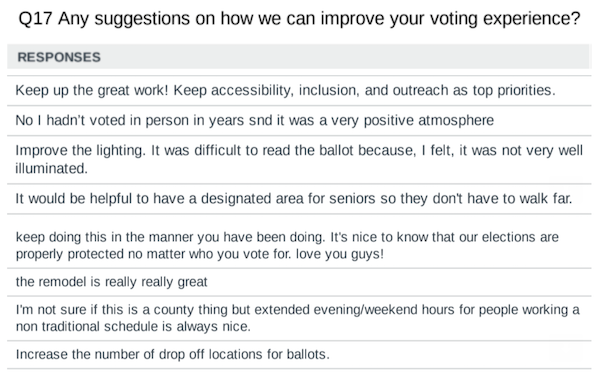
According to Peter, the most actionable feedback typically comes from voters’ written comments. As the team reviews the survey responses, they catalog the feedback in Cuyahoga County’s web-based Issue Tracker program. This centralized tool allows all of the staff to analyze any themes that came up in multiple voters’ responses, and make the appropriate adjustments. “Every entry in the Issue Tracker gets ‘resolved’ before we close the book on any given election,” says Peter. “So, depending on the comment, critique, or suggestion from the voter survey, we may very well make a process change in our operations.”
One such change was implemented in 2020, when the Board of Elections had to rethink their polling place layout to allow for social distancing. After the election, several survey respondents said that the layout changes caused difficulties for voters with disabilities. The elections team responded by changing where the ADA Ballot Marking devices were placed within the polling location. By listening to and acting on voters’ concerns, the Board of Elections was able to improve accessibility and demonstrate to voters that they are committed to improving their voting experience.
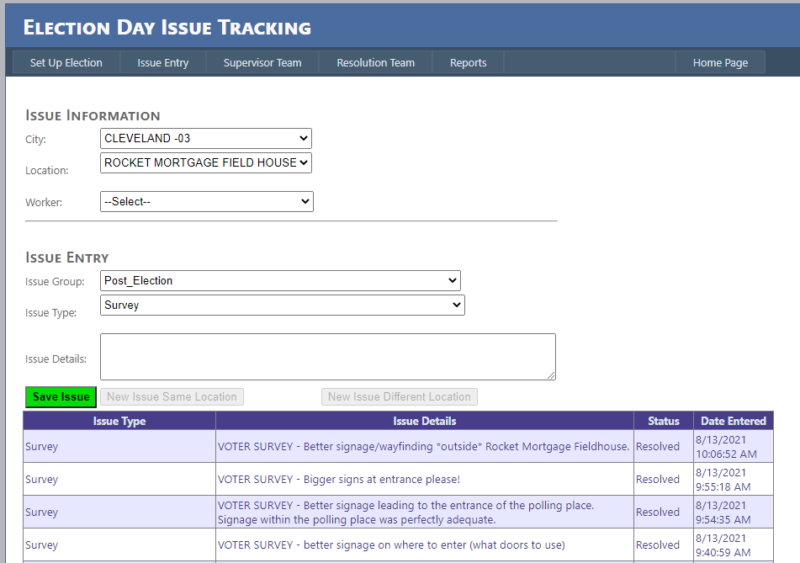
Voters typically fill out the surveys anonymously, but they can choose to provide their contact information if they’d like. This allows the elections staff to reply to any particular comments or questions that voters may have. If a voter is critical, say, about the signature verification process, the staff will respond and explain why they use a certain method or technology. “What we’ve found is that in most cases, a voter appreciates being heard, even if the final resolution isn’t completely satisfactory,” Peter says. Aside from showing voters that they are listening, it’s also an excellent opportunity for the Board of Elections to conduct voter education, albeit on a small scale.
Collecting Voter Feedback in Your Jurisdiction
If you’re thinking about using voter surveys in your jurisdiction, Peter says, “There are no drawbacks that we’ve seen from gathering feedback from the voters.” He explains, “At minimum, most voters will appreciate that you are making an effort to solicit their opinion.” Just be sure to ask the right questions that could generate actionable feedback.
The Cuyahoga County team also recommends having a plan to review the responses quickly after an election. It’s more productive to review feedback while the election is still fresh in everyone’s mind. “Additionally, responding to the voters in a timely manner increases their faith that the Board of Elections is interested in the feedback of their voters,” Peter says.
Other jurisdictions like DeKalb County, Georgia and Hudson County, New Jersey, similarly use voter surveys to gauge voters’ overall satisfaction levels. Election officials can also use surveys to receive feedback about specific questions. In Lynchburg, Virginia, the team created a survey to evaluate citizens’ opinions on in-person absentee voting hours. Election administrators in Knox County, Ohio asked voters whether they preferred precincts or voting centers. And in Missoula County, Montana, the election office partnered with the University of Montana to ask about perceptions of voter fraud and confidence in the elections process. So whether you’d like a general overview of how your team is doing, or insight on a specific issue, voter surveys can help point you in the right direction.
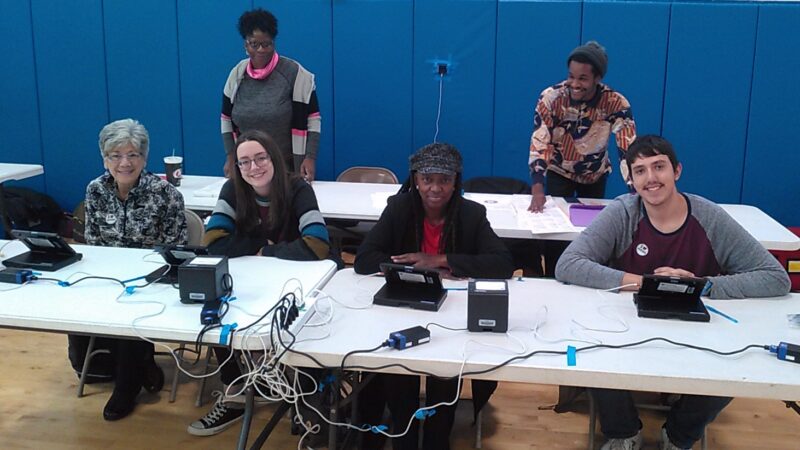
The Cuyahoga County Board of Elections doesn’t only solicit feedback from voters. They also send post-election surveys to their poll workers. Since poll workers interact directly with voters—often for many hours at a time—they can offer great insights and constructive criticism about the voting experience. These surveys also help the elections staff receive feedback about the poll worker trainings they conduct in preparation for Election Day. Hearing from both voters and poll workers ensures that the team can identify areas for improvement, and take action.
If you’d like to know more about how Peter and his colleagues set up these surveys in Cuyahoga County, you can reach out to him at [email protected]
We want to feature you next!
Is your election office doing exciting work that you’d like to share with other election officials across the country? Are you using technology in an innovative way to serve your voters? Would you like to be featured in one of our upcoming spotlight articles? Let us know by filling out our brief form. We look forward to hearing from you!
